Handiwork and playfulness: Ant Heald meets glass artist and innovator Rodney Bender
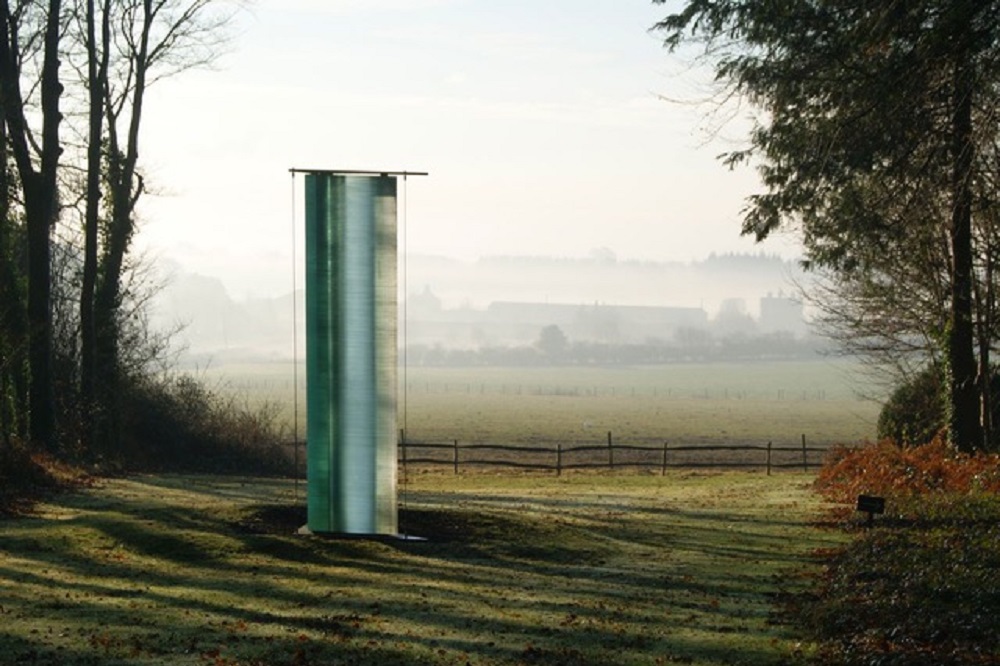
Ant Heald
For those of us for whom manual work extends no further than pecking at a keyboard, industrial estates are forests of inscrutable boxy buildings that we drive past on the way to the supermarket.
Maybe an ill-advised venture into the world of home-improvements might lead us to one of the bigger warehouse-stores that often front such industrial zones, proclaiming themselves ‘open to trade and public’.
But proper industrial estates, where stuff actually happens, where things get made not just traded, are a very different affair.
When I respond to Rodney Bender’s email confirming my visit and ask if it will be obvious where to go if I just SatNav the postcode, he replies with a PDF of instructions from various directions, including a map covered in arrows that reminds me of the opening credits of Dad’s Army.
Armed with this, it feels a little as though I’m scoping alien territory as I crawl through the entrance of Player’s Industrial Estate on the edge of Clydach, near Swansea, in my shiny little city car, edging past fleets of white vans and flatbed trucks, until after a few twists and turns I see a somewhat ramshackle white facade with ‘9c’ painted on it, and nothing else to confirm I have arrived at Innovative Glass Products (IGP).
The door is a forbidding continuation of the blank white wall, with no handle, and a cordless doorbell button held in place by sticky-tape next to it.
I press it, and within seconds the austere approach gives way to the warmest of welcomes, as Rodney, clad in red overalls and a Dickies (workwear uniform) cap, ushers me inside.
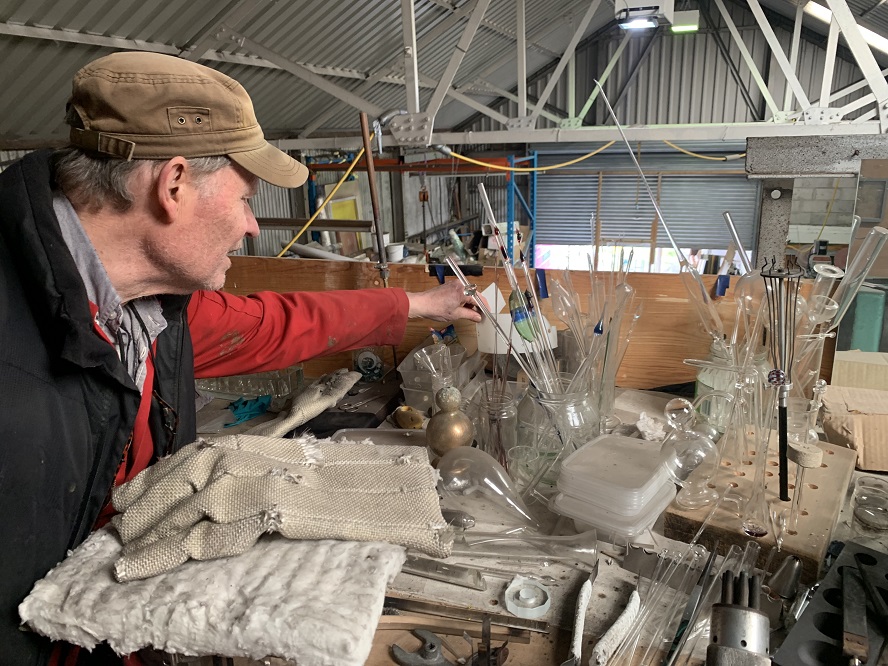
Process of experiment
The workshop is satisfyingly messy. The website of IGP is all sleek lines, clean white space and blue/green images of architectural and artistic glasswork neatly corralled into gallery grids, but the place from which these pristine products emerge is a visual cacophony of partially finished, abandoned and rejected pieces, scattered among inscrutable machinery, hand-tools and bits of detritus, alongside packages and pallets of finished items awaiting despatch to customers.
I have arrived at coffee time, expecting gritty instant, but instead a proper coffee machine dispenses an excellent Americano before Rodney leads us through to a yard at the back of the workshop, grabbing a couple of folding chairs on the way.
To the accompaniment of a chorus of barking dogs somewhere beyond the fence we chat first about the glass xylophone we had squeezed past on the way out.
That is not his only association with music making, as he enthuses about a recent commission to make a musical instrument that he describes as consisting of a resonant glass disc, fused with glass rods of varying lengths.
The player wets his fingers, and with a process akin to making a wine glass ring by rubbing its dampened rim, makes notes that vary according to the length of the rods.
The sound, he tells me, cannot really be compared to anything else and this process of experiment is the fascination for both him as craftsman and for the composer, who has been commissioned to create a new piece that Rodney thinks is being premiered sometime soon.
He can’t quite remember the name of the composer off the top of his head, but he’ll let me know.
“The funniest thing was seeing him head off for the train, staggering under this huge heavy glass thing in a cardboard box with bits sticking out everywhere.”
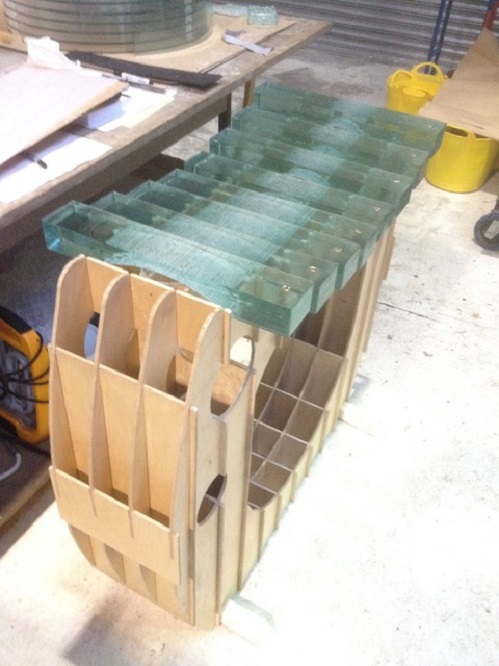
Bell-like sonority
Back in the workshop, Rodney plays a few notes on the xylophone, making the thick, arched-bridge shaped bars ring with a bell-like sonority that fills the space to its high rafters.
“Oh, I was commissioned to make that for the Wales Millennium Centre, for some event or other,” he offers, diffidently, “and I liked it so I made two and kept one for myself.”
It is Rodney’s association with the Welsh Millennium Centre (WMC) that brought Innovative Glass Products into being, and the ‘vitrophone’ as it was christened, was in fact stationed in the foyer of the centre for the public to play, so it will have given aural pleasure to countless thousands of visitors, just as the patented glass product from which it is made will have offered visual delight to many more.
KiloLux forms a significant element of the facade of the Millennium Centre, offering as it does the structural strength and integrity of brick, while allowing sunlight to stream in, filtered and fractured through its layered structure, sandwiched between the slate blocks of that magnificent building.
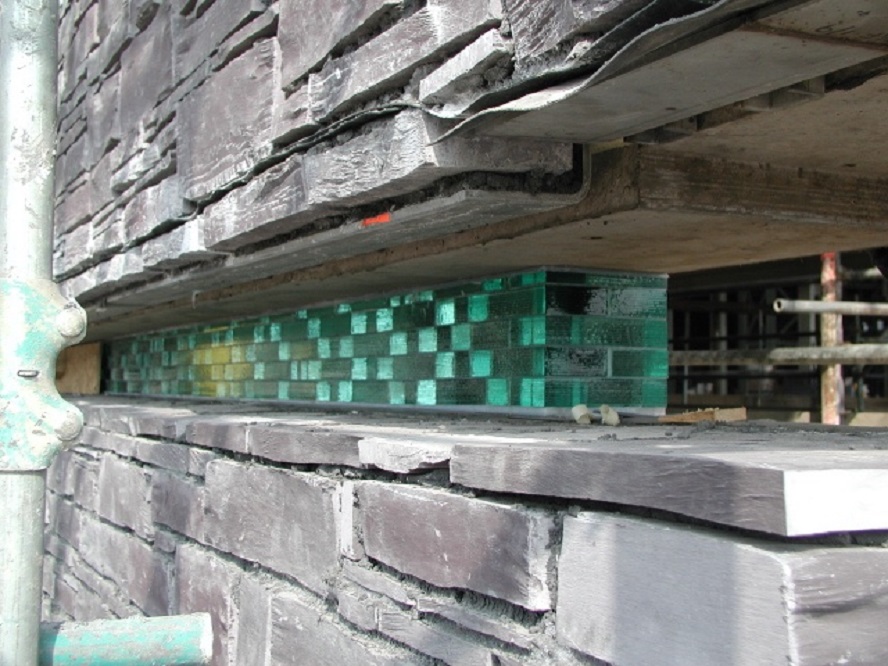
Architectural and artistic
In his softly spoken Australian accent, Rodney tells me how he wound up in Wales.
Born in Brisbane, he started working in stained glass in Adelaide before a Welsh girl tempted him to cross the globe in 1978.
He studied at the renowned glass department at Swansea College of Art (now part of University of Wales, Trinity Saint David – UWTSD), eventually rising to head the department.
It was at the tail end of the 1990s that Rodney began work to develop a bespoke product for Jonathan Adams, architect of the WMC, that would combine structural strength and weather-sealing properties with light transmission and aesthetic beauty.
Kilolux was developed, patented, and rigorously tested to meet the architectural demands of the iconic building.
With the product’s architectural and artistic value established, Rodney started IGP as a company in 2001 as the main outlet for his work, though he retains an association with UWTSD as a Research Fellow.
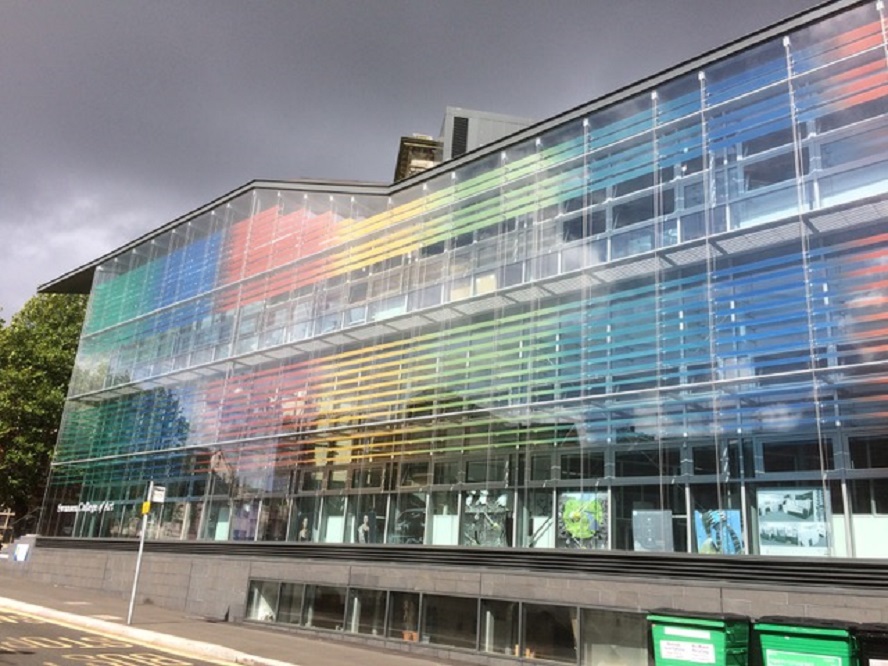
Stained-glass
Although the company has branched into an eclectic range of products, Rodney’s roots in artistic stained glass remain.
Propped against the light flooding in from the yard at the back of the workshop, a seabird peeps through daffodils in a stained glass memorial window to commemorate the Warden of a nearby church, and many will have seen his Welsh Guards Falklands Memorial window in the Church of St Mary, Swansea, which dates back to 1985 and was inspired by the Dylan Thomas poem, ‘And Death Shall have no Dominion’.
Elsewhere Rodney tells me that a stack of thick-walled rectangular vessels, looking rather like small fish tanks, are produced for a medical company for use in blood testing under heat and pressure where the purity and strength of the glass is critical.
On a mezzanine level upstairs, a bench is crowded with blown and fused glass implements and oddments that might be from some alchemical laboratory; nearby is a sculptural feature in glass and metal, taller than us both.
Like many of the items scattered around the workshop, Rodney is somewhat vague about when or why it was made; there is so much stuff, how would he remember?
“Do you want it?” he asks, and not entirely sure that he’s joking, I quip that I wouldn’t get it home in one piece in my tiny car.
Elsewhere, a shallow square of glass is full of moss, and he tells me he often experiments with incorporating natural materials into his work “just to see what’ll happen”, pointing to a huge sheet of glass flecked with embedded greenery, then back to the glass square “and I saw that thing and thought it would make a nice little moss garden.”
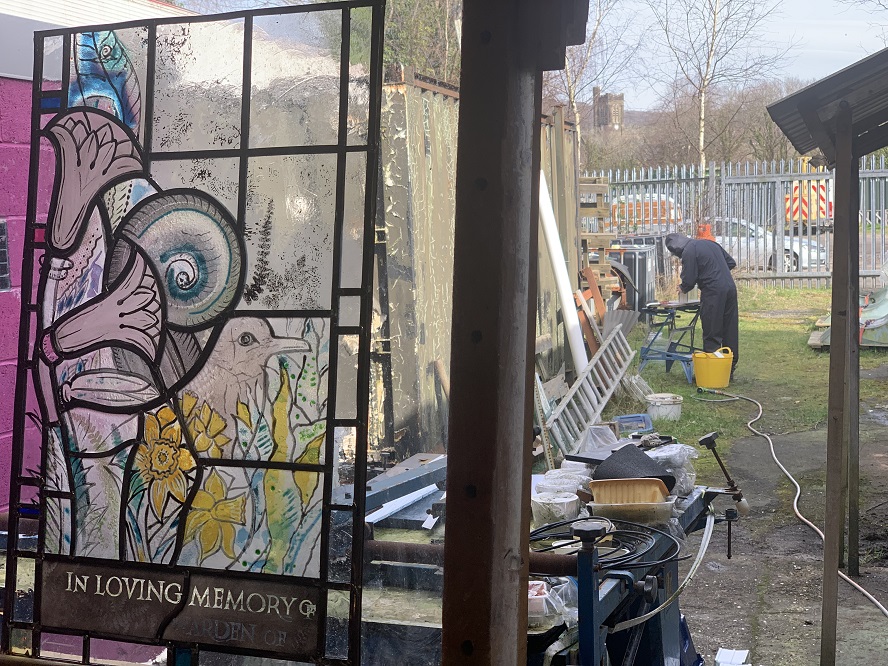
History and origins
Handiwork and playfulness are here wedded to hi-tech, though the latter is fairly well hidden.
A couple of laptops lurk; one is perched at the edge of huge red boxy machine that looks to me a little cumbersome and make-shift but turns out to be a high precision laser cutter and etcher.
This has allowed IGP to branch into materials other than glass. There are few bright blue acetate clouds stacked against a bench that will form part of a weather education kit for schools, and one of Rodney’s favourite creations (a nod to his Aussie roots?) is a slot-together MDF camper-van, complete with surfboard, produced for a Swansea based company that sells app-controlled models to teach coding to schoolchildren.
Actually, the big red machine is really why I am here. Last year I was honoured to receive a very handsome trophy, designed and made by Rodney.
The Nigel Jenkins Literary Award was presented at an evening in honour of the late great poet and writer, at which Rodney spun a tale, weaving the history and origins of the materials and skills that came together over the years to link the slab of Venetian glass from which the trophy was fashioned, his own life journey from the antipodes to Wales, and the hometown and muse of Jenkins: Swansea.
After the presentation ceremony, Rodney told me to get in touch for a visit to have my name etched on the trophy.
Now I have finally got round to making that visit and watch as my name is entered into the software on the laptop and a test piece of glass placed on the bed of the machine.
The laser light is generated somewhere within the heart of the machine, fired along its back axis then turned ninety degrees down the side by one mirror to another that sends it into a flexible optic fibre that snakes backwards and forwards across a moving arm, carrying the light to the cutting head.
There, lenses focus the laser so precisely as to vaporise a microscope layer of the glass, leaving my name precisely etched into the surface.
Rodney holds it up against the trophy to check the measurements he entered do indeed marry up with the text already inscribed on it, places the trophy precisely against the guidelines, recalibrates the thickness on the laptop, and the machine whirs into action again, flashing over the surface like a monster inkjet printer. In less than ten sparkly seconds, the trophy is indelibly marked as mine.
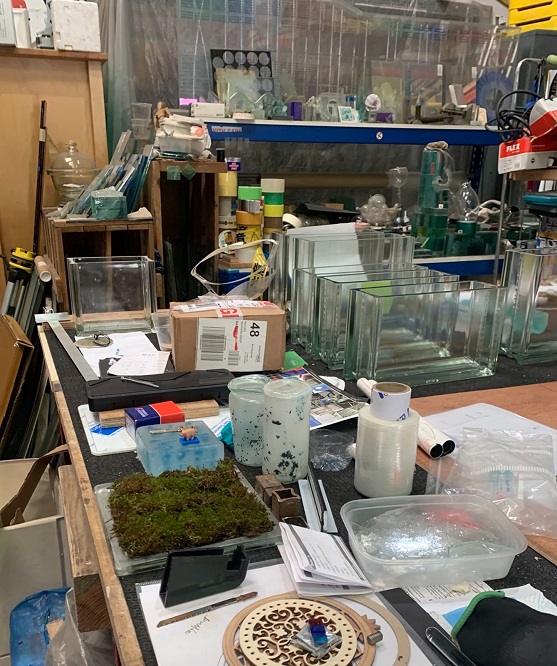
Sequanaphone
The connections between industrial processes, craftsmanship and both participating in and supporting the arts are clearly central to Rodney’s practice, and I come away with far more than my name on a beautiful piece of glassware.
He not only remembers the name of the composer, Louis d’Heudieres, but copies me into an email introducing us, and soon I am both absorbed in a corner of the musical world that was completely new to me, and engaged in an enthusiastic correspondence with Louis, who tells me all about the genesis of the instrument.
“It’s called the Sequanaphone, named after the river Seine, which inspired Debussy throughout his career.” He continues to fill me in a little on the process of collaboration that led to this one-of-a-kind instrument.
“Rodney even explained to me that because of its molecular structure, glass is actually somewhere between a solid and a liquid!
“Old stained-glass windows literally dribble, it just takes them hundreds of years before we notice it. This blew my mind!
“A double bonus with glass is that you can activate it sonically by wetting your fingers. Rodney sent me a couple of examples of glass instruments, and the Bachet Crystal was the one that I found the most interesting.
“So we set off on the principle that it would be friction-based, and activated with moistened fingers.”

As I work on this article, I think of Louis composing the first work that will be heard from the sequanaphone later this year, and recognise that while my offering here is rather more modest, we have both had much the same experience: in meeting Rodney Bender, we have been in the presence of someone who is not only both an artistic and technical master in his own right, but a generous catalyst for others’ creativity.
And a maker of excellent coffee and conversation, should you too get the chance to visit.
Support our Nation today
For the price of a cup of coffee a month you can help us create an independent, not-for-profit, national news service for the people of Wales, by the people of Wales.




